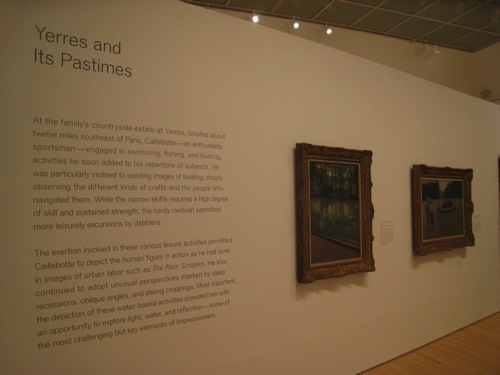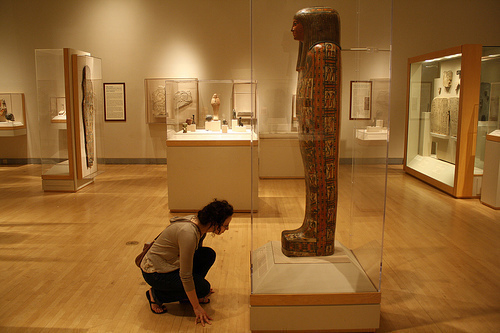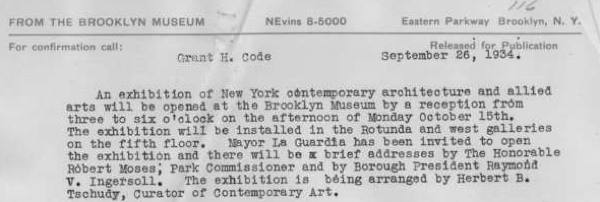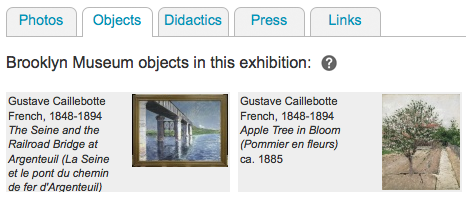Data Entry meets API Synergy
I’m telling you, this has been a long, never ending haul. We’ve been quietly working on a number of ways to improve our online collection and our exhibition archive. Sometimes these things take a lot of time and require boatloads of aspirin. Here’s a run down of what’s new:
Object labels now online. Our curators write tons of chat labels for the objects in the galleries and we’ve gone through and digitized them, which was not an easy process. Francesca found the easiest way to get the data was to go through the galleries with a camera and take photographs of each label and then OCR the photo to get the text for proofing. Yeah…it was a pain, but it worked and, in doing it this way, we knew we had the absolute latest text on the wall. This was Francesca’s final project with us and I think she was more than excited to move back to Australia after dealing with this mountain of data entry. Moving forward, our Design Department now gives us the final versions in PDF format, so we just cut and paste to get them out to the web. As I wave across the world and give a big thank you to Francesca, I can say there are now over 2500 labels online.
Checking out the object label for the Cartonnage of Nespanetjerenpere—now also online. Photo via timothycgoodwin on Flickr. All Rights Reserved.
Pushing press releases out the door. We’ve been working to fill out our exhibition archive, which has records of every exhibition staged here with dates and, when available, includes photography of the installations. That was a lot of data to push out the door, but we recognized there was a lot more we could do to give a fuller picture of some of the contents of each exhibition. Erin, with the help of our editors Joe and Jillian, has long been working on a project to digitize our archive of press releases, which give a wealth of contextual data around a given show. Erin was dealing with no easy task—trying to OCR some of these records was a nightmare…differences in typewriter style from way back when combined with paper in various conditions equals OCR going #@$@#% and that’s enough to give anyone a headache! Through thick and thin, she’s managed to digitize everything from 1929-1950 and 2000-present. We are still working on the years between ’51-’99, but we’ve managed to push out over 700 press releases for 446 exhibitions and more are on the way.
Detail of a 1934 press release for the Contemporary New York City Municipal Architecture and Allied Arts exhibition. Along with the text, we’ve included the original image of the releases and it’s pretty fun to go through and compare how these looked from year to year. Perhaps not so fun to digitize, but cool to see how things changed—check out the old phone exchange at the top of the release!
Didactics from exhibitions are now going online as well. We managed to get a stash of these from our Design Department going back seven years, so after a monster round of data entry in every spare moment of my time, you can find 530 didactics for 109 exhibitions and we’ll continue to upload them as we get them.

Exhibition didactic from Caillebotte—now online under the didactics tab.
Brooklyn Museum objects in exhibitions. Paul with the help of our Collections Manager, Chrisy, has hooked up the collections database to the Exhibition Archive and we can now list Brooklyn Museum objects that were in these shows. This is a long project data entry project that we’ve just begun, but you can see the seeds of this taking root in records like Caillebotte (below), Tissot and Brushed With Light.
New York Times API synergy. Our hometown paper is the NYT and, luckily, they’ve created an API which means we can access their data. Paul has worked to match up related NYT articles with our exhibition archive and that means we can display stubs and links to NYT reviews, listings and other fun things under the press tab. Currently the NYT Article Search API only goes back to 1981, but we hope they will release the entire archive eventually—with records in our exhibition archive going back to 1843, you can imagine how many matches we could have one day. The great thing about utilizing an API? No data entry!
Come together now. To see all of this work in one place, check out the record for Tissot. We’ve got installation photos, didactics, the press release, the NYT press coverage and 124 of the Brooklyn Museum objects in the show…along with all of their object labels. Whew!

Shelley Bernstein is the former Vice Director of Digital Engagement & Technology at the Brooklyn Museum where she spearheaded digital projects with public participation at their center. In the most recent example—ASK Brooklyn Museum—visitors ask questions using their mobile devices and experts answer in real time. She organized three award-winning projects—Click! A Crowd-Curated Exhibition, Split Second: Indian Paintings, GO: a community-curated open studio project—which enabled the public to participate in the exhibition process.
Shelley was named one of the 40 Under 40 in Crain's New York Business and her work on the Museum's digital strategy has been featured in the New York Times.
In 2016, Shelley joined the staff at the Barnes Foundation as the Deputy Director of Digital Initiatives and Chief Experience Officer.



